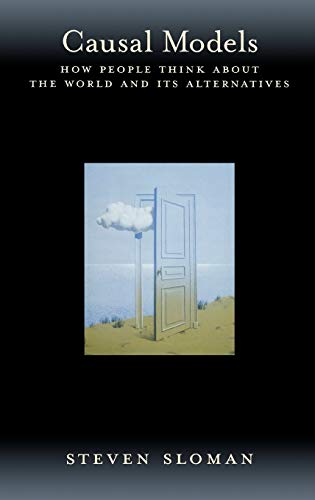Verwandte Artikel zu Causal Models: How People Think about the World and...

Inhaltsangabe
Human beings are active agents who can think. To understand how thought serves action requires understanding how people conceive of the relation between cause and effect, that is, between action and outcome.
In cognitive terms, the question becomes one of how people construct and reason with the causal models we use to represent our world. A revolution is occuring in how statisticians, philosophers, and computer scientists answer this question. These fields have ushered in new insights about causal models by thinking about how to represent causal structure mathematically, in a framework that uses graphs and probability theory to develop what are called 'causal Bayesian networks'. The framework starts with the idea that the purpose of causal structure is to understand and predict the effects of intervention: How does intervening on one thing affect other things? This question is not merely about probability (or logic), but about action. The framework offers a new understanding of mind: Thought is about the effects of intervention, so cognition is thereby intimately tied to actions that take place either in the actual physical world or in imagination, in counterfactual worlds.
In this book, Steven Sloman offers a conceptual introduction to the key mathematical ideas in the framework, presenting them in a non-technical way, by focusing on the intuitions rather than the theorems. He tries to show why the ideas are important to understanding how people explain things, and why it is so central to human action to think not only about the world as it is, but also about the world as it could be. Sloman also reviews the role of causality, causal models, and intervention in the basic human cognitive functions: decision making, reasoning, judgement, categorization, inductive inference, language, and learning. In short, this book offers a discussion about how people think, talk, learn, and explain things in causal terms - in terms of action and manipulation.
Die Inhaltsangabe kann sich auf eine andere Ausgabe dieses Titels beziehen.
Über die Autorin bzw. den Autor
Steven Sloman has been on the faculty in Cognitive and Linguistic Sciences at Brown University since 1992. He completed his undergraduate studies at the University of Toronto in 1986 and received a Ph.D. in Psychology from Stanford in 1990. He has published many papers and a book about human cognition on topics ranging from categorization and memory to decision-making, inductive inference, and reasoning.
„Über diesen Titel“ kann sich auf eine andere Ausgabe dieses Titels beziehen.
EUR 8,02 für den Versand von USA nach Deutschland
Versandziele, Kosten & DauerNeu kaufen
Diesen Artikel anzeigenEUR 5,73 für den Versand von Vereinigtes Königreich nach Deutschland
Versandziele, Kosten & DauerSuchergebnisse für Causal Models: How People Think about the World and...
Causal Models : How People Think about the World and Its Alternatives
Anbieter: Better World Books, Mishawaka, IN, USA
Zustand: Good. Former library book; may include library markings. Used book that is in clean, average condition without any missing pages. Artikel-Nr. 45116701-6
Anzahl: 1 verfügbar
CAUSAL MODELS: HOW PEOPLE THINK ABOUT THE WORLD AND ITS ALTERNATIVES.
Anbieter: Burwood Books, Wickham Market, Vereinigtes Königreich
Hardcover. Zustand: Fine. First Edition. Hardback. Dust Jacket. 8vo. Some figures throughout. ISBN: 0-19-518311-8 Pages: 224 Fine in fine dust wrapper. Artikel-Nr. C90839
Anzahl: 1 verfügbar
Causal Models: How People Think about the World and Its Alternatives
Anbieter: Ria Christie Collections, Uxbridge, Vereinigtes Königreich
Zustand: New. In. Artikel-Nr. ria9780195183115_new
Anzahl: Mehr als 20 verfügbar
Causal Models : How People Think about the World and Its Alternatives
Anbieter: AHA-BUCH GmbH, Einbeck, Deutschland
Buch. Zustand: Neu. Neuware - Human beings are active agents who can think. To understand how thought serves action requires understanding how people conceive of the relation between cause and effect, that is, between action and outcome.In cognitive terms, the question becomes one of how people construct and reason with the causal models we use to represent our world. A revolution is occuring in how statisticians, philosophers, and computer scientists answer this question. These fields have ushered in new insights about causal models by thinking about how to represent causal structure mathematically, in a framework that uses graphs and probability theory to develop what are called 'causal Bayesian networks'. The framework starts with the idea that the purpose of causal structure is to understand and predict the effects of intervention: How does intervening on one thing affect other things This question is not merely about probability (or logic), but about action. The framework offers a new understanding of mind: Thought is about the effects of intervention, so cognition is thereby intimately tied to actions that take place either in the actual physical world or in imagination, in counterfactual worlds.In this book, Steven Sloman offers a conceptual introduction to the key mathematical ideas in the framework, presenting them in a non-technical way, by focusing on the intuitions rather than the theorems. He tries to show why the ideas are important to understanding how people explain things, and why it is so central to human action to think not only about the world as it is, but also about the world as it could be. Sloman also reviews the role of causality, causal models, and intervention in the basic human cognitive functions: decision making, reasoning, judgement, categorization, inductive inference, language, and learning. In short, this book offers a discussion about how people think, talk, learn, and explain things in causal terms - in terms of action and manipulation. Artikel-Nr. 9780195183115
Anzahl: 2 verfügbar
Causal Models: How People Think About The World And Its Alternatives
Anbieter: Revaluation Books, Exeter, Vereinigtes Königreich
Hardcover. Zustand: Brand New. 1st edition. 212 pages. 9.25x6.25x0.75 inches. In Stock. Artikel-Nr. x-0195183118
Anzahl: 2 verfügbar

